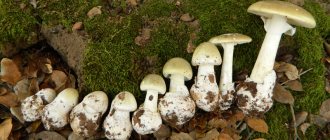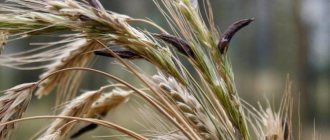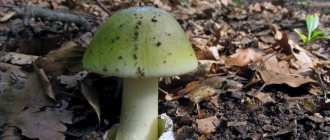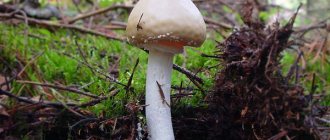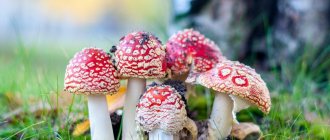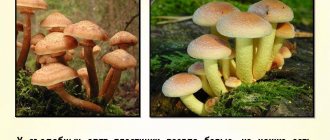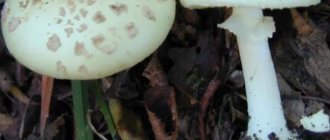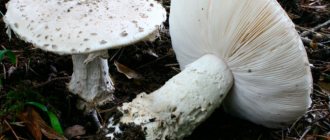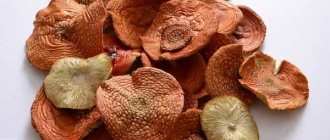One of the most severe types of intoxication is mushroom poisoning. Eating poisonous or conditionally edible mushrooms can cause serious problems and even death. Poisoning occurs due to negligence during collection, lack of understanding of the differences between different mushrooms, improper processing and preparation of mushroom dishes.
Poisonous fly agarics.
Pale grebe in history
The first mention of the toadstool dates back to the 19th century, when the famous American scientist Charles Peck first mentioned a mushroom that he noticed in North America. In 1918, the samples taken by this scientist were tested and scientists came to the conclusion that it belongs to the fly agarics. At that time, everyone sincerely believed that the pale grebe grew only where it was first seen. But in the seventies of the last century, scientists noticed that this fungus had also spread along the East and West coasts of North America, and had also taken root well in Europe.
In fact, it was in Europe that the toadstool began to grow from the very beginning, and then it spread widely due to the fact that seedlings of trees, especially the then popular chestnuts, which already contained fungal spores, were transported to other countries. It only took 50 years for the toadstool to become so widespread, and although it loves damp places, it can increasingly be found in countries that are not known for their humid climate.
The first documented case of poisoning with toadstool in history, at least a noticed case, can be considered the family of the famous Euripides, who were poisoned by pale toadstool, confusing it with the common Caesar mushroom.
Much later, the first mentions appeared that people were poisoned with pale toadstool specifically in order to eliminate people from the political arena. In particular, Emperor Claudius and Pope Clement 7 became victims of poisoning with this mushroom.
Is it possible to get poisoned by rows?
There are more than 45 species of these mushrooms, among which there are both edible and poisonous representatives. The distribution area of the rows is quite extensive. They grow throughout the middle zone in birch and coniferous forests, preferring edges with calcareous soil. They often grow in large groups. The first harvest of rows can be harvested at the end of July. Mass harvest occurs in August-September.
The young fungus has a spherical cap that is white, brown or gray. Then the cap opens, becoming almost flat, and only the edges are slightly curled down. Its diameter rarely exceeds 10 cm. A mature cap has small, frequent flake-like scales on its skin, which are located along the entire circumference. They are usually darker in color than the main color of the mushroom.
At the bottom of the cap there are gray plates with a yellow or green tint - fleshy, wide and quite sparse. As the mushroom matures, droplets of clear liquid may appear on them. The leg is white, cylindrical, without a solid hole. The flesh is crispy and dense. When cut, the color does not change, remaining grayish-white. The edible row has a characteristic spicy mushroom aroma.
Few would call this mushroom “handsome.” The earthy, dull color and cracked scales make it inconspicuous. But the existing dangerous types of rows may have a brighter color: pure white, green and variegated “tiger”.
These mushrooms are poisonous and can cause severe poisoning.
Where does the toadstool grow?
The pale grebe loves moisture very much and after rain a huge number of them appear. It appears quite rarely in countries with arid climates, as well as in areas characterized by dry, hot weather. The mushroom prefers mixed and deciduous forests, but this does not mean that it cannot be found in coniferous forests. Mushrooms reach their peak of development from the second half of August until October.
The birthplace of the pale grebe is Europe, after which it penetrated into Asia and Africa, spreading throughout America and Australia. In fact, the pale grebe is not so common, but nevertheless there are many places that it prefers to live. The pale grebe feels best next to oaks, chestnuts, birches, maples, lindens, hazels, beeches, and elms. But it was also noticed next to conifers: fir trees and pines. The pallid grebe is also now spreading throughout the world; recently it has become noticeable that it is finding trees as partners that were previously unusual for it. For example, the pale grebe is now doing quite well in Iran, where it grows next to hazelnuts, and has even been seen in Algeria, where it uses eucalyptus.
Poisonous rows
There are several varieties of inedible rows. And all of them pose a threat to human life and health. Therefore, it is especially important to know their characteristic features.
Poisonous rows include:
White row
The cap and stem of the young mushroom are painted a pleasant white color. Later, yellowish scales appear. The cap is fleshy and dense with edges rounded down, its diameter is from 5 to 8 cm, less often up to 10 cm. The skin on it is dry, without an oily sheen. The leg is cylindrical, smooth, 10-12 cm long. The young row is often confused with champignon.
Pointed row
The cap of this type of row has a conical shape and usually does not exceed 7-8 cm. The color of the mushroom is from light ash to dark gray. As it grows, white-gray scales appear on the cap. The plates under the cap are the same color. The leg is straight, slightly widening towards the base, its length is up to 8 cm.
Brown row
The name of the row speaks of its color: the stem and cap of this mushroom are light brown, darkening slightly over time. The entire cap is covered with whitish scales, and a raised tubercle appears in its center.
Poisonous row
Otherwise it is called “tiger” or “leopard”, because of the dark scales on the gray or light brown background of the cap. In a young row, the cap has the shape of a ball, with age it unfolds and becomes almost flat and quite large, from 12 cm. The plates are initially barely noticeable, later they become clearly protruding, wide and infrequently gray in color. Droplets of liquid appear on them. The gray-white leg is smooth, fleshy, straight.
All these mushrooms grow mainly in damp coniferous forests, but sometimes they can also be found in mixed groves.
Poisonous rows have an unpleasant, pungent odor and a pungent, pungent taste. But trying them is extremely dangerous. Since they are all from the category of toxic mushrooms. They contain a little-studied toxin; its amount in different types of rows may vary. For example, the white row contains much less of it than the brindle one.
Therefore, mycologists believe that poisoning by the white mushroom is easier to treat, and the pointed and tiger mushrooms are considered the most dangerous representatives of this family. If these mushrooms get into food, they not only cause food poisoning, but also have a detrimental effect on other organs and systems and can lead to death.
How to identify a pale grebe
Young toadstool mushrooms have a cap shape similar to a chicken egg; gradually the cap becomes flatter, but retains a convexity in the center. For the most part, toadstools have a greenish tint, which is easy to notice when cut. This green color is especially noticeable on the stem, which has green veins or patterns. At the top of the toadstool's leg there is a small whitish ring, which may not be solid. In addition, the pale grebe's calyx is torn into several lobes, usually 4 pieces, which are located near the ground. These are very noticeable features, since the stem does not grow to this cup; on the contrary, it seems that the mushroom was simply placed in it. Additionally, the calyx is quite large compared to other mushrooms. Old mushrooms have an unpleasant sweet smell, by which they can be distinguished.
Treatment
The exact diagnosis and correct treatment method can only be determined by a specialist after the victim has undergone a medical examination.
In case of poisoning, massive use of medications aimed at detoxifying the body is used. If the disease provokes disturbances in the functioning of the cardiovascular system or kidney failure, then measures are taken to restore the normal functioning of the damaged organs. Correction of homeostasis and the use of medications with hepatoprotective effects may be necessary.
During treatment and several weeks after it, the victim will have to adhere to a dietary menu. This will reduce the burden on the body weakened by the disease. It is recommended to consume fortified foods that help strengthen the immune system.
Row poisoning is a serious disease. If help is not provided to a person in time, he can be seriously injured. Therefore, do not pick unfamiliar mushrooms in the forest. It is better to discard questionable specimens than to later be treated for poisoning.
Folk signs
It is very important to understand that folk signs are not always able to help you determine whether a mushroom is poisonous or not. There are several common misconceptions that can really cost the life of a careless mushroom picker:
- All poisonous mushrooms have an unpleasant smell, but edible ones have a pleasant smell. Pale grebe is very often similar in smell to champignons, and some of the species have no smell at all, so this sign cannot be considered correct.
- Insect larvae never live in poisonous mushrooms. In fact, this is not true; the larvae of some insects feel quite comfortable even in a poisonous mushroom.
- All mushrooms, if they are young, can be eaten. Let's not judge all mushrooms, but toadstool is deadly at any age.
- If you make a decoction of a poisonous mushroom and put silver in it, the silver will definitely turn black. The range of toxic substances contained in various poisonous mushrooms is very diverse. It is possible that some mushrooms affect silver in this way, but this does not mean that this remedy can be considered the correct way to find out whether a mushroom is poisonous or not.
Prognosis and prevention
If the victim is immediately taken to a medical facility after the appearance of primary symptoms of poisoning, where he receives all the necessary assistance, the prognosis is favorable. The therapy allows you to quickly remove toxins from the body, so the risk of developing severe disorders of the internal organs is minimal.
If the patient is brought to a medical facility after the period of apparent well-being has ended, the prognosis is worse. Up to 70% of such patients die 2-3 days after hospitalization.
To prevent mushroom poisoning, it is recommended to collect them only in environmentally friendly areas. People who do not have experience in this matter are advised to study in advance the types of mushrooms that can be eaten. If possible, you should learn to pick mushrooms under the supervision of an experienced mushroom picker.
Unknown species must not be collected or eaten. You should not buy fruiting bodies from unfamiliar people. It is not recommended to collect fruits that grow in close proximity to poisonous fellows.
Use in medicine
It is possible that the toadstool contains substances that can be used in pharmaceuticals, but at the moment humanity does not know about them, it is only known that it is a deadly mushroom. Just a third of the mushroom is enough to cause severe poisoning and possible death. A minimal amount of toadstool is used in homeopathy, but official medicine has never recognized and will not recognize this mushroom as a medicine in the near future. Remember that the toxins it contains are too dangerous to experiment with your own health in an attempt to recover.
In the Middle Ages, doctors used minimal doses of toadstool in attempts to treat cholera. At the moment, microscopic doses of this mushroom, infused with alcohol, are used in homeopathy to treat gastritis and cholera, stomach cramps, lethargic sleep, serious damage to the eye muscles and even vertigo. However, it is important to remember that any use of the wrong products can be dangerous rather than beneficial to health.
Possible consequences
After consuming a quarter of the weight of one average fruiting body of the pale grebe, which weighs 70–100 g, an adult develops severe intoxication, and a child, due to high sensitivity to toxins, experiences death.
There is no consensus on the lethal dose, but most researchers believe that the following doses are lethal: α-amanitin 5-7 mg, phalloidin 20-30 mg.
Thus, a fatal outcome for a middle-aged adult man in 90-95% of cases occurs when eating 1 mushroom.
Toadstool poisoning
The poison contained in the toadstool inhibits the functioning of every cell in the body. It significantly inhibits the formation of proteins in the body, which leads to rapid degeneration of tissues and internal organs. It is for this reason that the stomach, liver and intestines are the first to suffer. In addition, this leads to vomiting and diarrhea, which in turn leads to dehydration and loss of beneficial salts.
Doctors say that the toxins contained in this mushroom change the composition of the blood and greatly impair the functioning of the heart, and also affect the lungs. They significantly reduce the blood's ability to clot, which leads to internal bleeding. In addition, they poison the nervous system, which ultimately leads to hallucinations and inappropriate behavior.
Unfortunately, not only the toadstool itself is dangerous, but also its spores. The wind spreads them to plants adjacent to the fungus, so when picking berries and herbs in the forest, you need to pay attention to their neighbors. Of course, toadstool spores are not enough to cause death, but they are quite enough to cause serious poisoning.
Stages of poisoning
The main problem with toadstool is not only its toxicity, but also the fact that the first symptoms of poisoning can appear long after you have eaten this mushroom. The toxic substances contained in this mushroom begin to act only 10 to 30 hours after you eat it. Often the first symptom of poisoning is a common headache, then vision becomes much worse, excruciating pain in the stomach, anxiety and thirst appear. After this, poisoning quickly moves into a more active phase: convulsions, diarrhea and vomiting appear. Some poisoned people experience periods of relief, but in reality this is a hoax. By the time the first symptoms subside, irreversible changes have already occurred in the internal organs, in particular in the heart, kidneys and liver.
Once toxins enter the bloodstream, death occurs within about 10 days. For a person, only 1/3 of an adult mushroom is enough to die.
However, with the modern level of medicine, there is a very high chance of survival: at the first suspicion of poisoning with toadstool, if you seek help in time, in the first hours of pronounced symptoms, the fatal outcome is reduced to 50%.
What to do in case of poisoning
First of all, at the first manifestations of the slightest signs of poisoning with toadstool, it is necessary to rinse the stomach. Old proven methods, that is, a solution of potassium permanganate, are best suited for this. If you don’t have it on hand and you can’t make a weak solution of potassium permanganate, you need to drink 5 glasses of boiled water and then induce vomiting. Under no circumstances should you drink milk, as it stimulates faster absorption of toxins into the blood. Ordinary activated carbon or other effective sorbent, which you need to drink about 5 tablets, can also save lives. Vitamin C in a small dosage, up to one gram, will also help. Antibiotics will also help, for example, ordinary “Levomycetin”, which will reduce the effect of toxins on microorganisms in the intestines. Before the ambulance arrives, it is very important to drink water, to which you need to add a little salt, to restore the balance of salt and water in the body that has been disrupted due to vomiting and diarrhea.
Best materials of the month
- Coronaviruses: SARS-CoV-2 (COVID-19)
- Antibiotics for the prevention and treatment of COVID-19: how effective are they?
- The most common "office" diseases
- Does vodka kill coronavirus?
- How to stay alive on our roads?
What not to do if poisoned
Some people believe that strong alcohol can help with poisoning, but in fact this is not the case. On the contrary, any alcohol helps toxins spread throughout the body even faster, stimulating a fatal effect.
First aid before the ambulance arrives
All mushroom pickers should understand what to do if signs of poisoning arise after eating collected mushrooms. It is imperative to call an ambulance and provide first aid to the victims.
It is recommended to immediately perform gastric lavage. To do this, drink at least 1 liter of warm, salted water, and then induce vomiting.
A person showing signs of poisoning should be given as much water as possible to replenish lost fluids. It is also recommended to take a saline laxative. If possible, you should do an enema to cleanse the intestines. To bind the toxic substances of the toadstool, you should take a sorbent. Even activated carbon can improve the situation. Ambulance doctors deliver the victim to the hospital inpatient unit for further hospitalization.
First aid for mushroom poisoning - cleansing the stomach and intestines
Creation of an antidote
At the moment, substances have been isolated from the toadstool that can neutralize the poison of this fungus. An antidote is being actively developed that will make it possible to most actively treat poisoning by this fungus. But it is very important to remember that the only way to recover from toadstool poisoning is to consult a doctor in a timely manner, since after just a few days the toxins contained in it lead to irreversible damage to internal organs, which can be fatal without a transplant of these organs.
More fresh and relevant information about health on our Telegram channel. Subscribe: https://t.me/foodandhealthru
We will be grateful if you use the buttons:
Diagnosis of intoxication
When a patient enters a medical facility, doctors collect anamnesis to clarify when the poisoning could have occurred, conduct an examination and assess vital signs. After this, general and biochemical blood tests are performed. In addition, it is prescribed:
- coagulogram;
- encephalogram;
- Ultrasound of the abdominal organs;
- ECG;
- hemodynamic studies;
- determination of hourly diuresis;
- MRI;
- CT.
A comprehensive study makes it possible to determine the dosage of poison that has entered the patient’s body, as well as the severity of disturbances in the functioning of internal organs.
